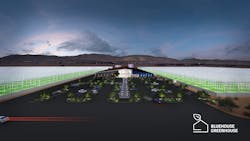Endurant Energy jumped into the controlled environment agriculture (CEA) sector with a roughly $30 million microgrid project for Bluehouse Greenhouse, a company building a high-tech 62-acre greenhouse in Southern California.
Endurant (formerly GI Energy) will own, operate and maintain the 13.2-MW microgrid using an energy-as-a-service (EaaS) model.
The project is Bluehouse’s first greenhouse. The company is also scouting sites in the Southwest and Northeast with a goal of starting work on three more greenhouses in the next three years, according to Shane Holland, a company spokesman.
Endurant, which was recently bought by LS Power, is planning to provide the EaaS model to Bluehouse on those projects.
“We are very excited about our partnership with BHGH and our participation in the expanding agriculture tech sector,” Tom Chadwick, Endurant chief executive officer, said Aug. 9. “Endurant understands the importance of reliable, affordable and efficient energy generation to CEA.”
Combined heat and power drives microgrid
The project will include four 3.3-MW, natural gas-fired ECOMAX combined heat and power (CHP) systems built by AB Energy USA, according to Jeff Bogg, Endurant senior vice president for service solutions.
The CHP systems will produce electricity, hot water, chilled water and recover carbon dioxide. The hot water can be used directly in the greenhouse or stored in thermal energy storage systems. The project also includes hot water driven absorption chillers for cold water, which can also be used directly or stored. Recovered carbon dioxide will be pumped into the greenhouse to accelerate plant growth and productivity.
There will also be a backup natural gas boiler and two, 2-MW emergency diesel generators, according to Bogg. Endurant hasn’t settled on a microgrid control for the project yet, he said.
The microgrid system is called Bluehouse Energy. By using typically wasted byproducts of power generation such as heat, water and carbon dioxide, the Bluehouse Energy system’s efficiency increases from an average of 50% to more than 95%, according to Bluehouse.
Interested in microgrids for agriculture? Join us for Microgrid California on October 5 in Foster City, California
The greenhouse will get “fairly significant” cost savings through the CHP generation compared to buying power off the grid, according to Bogg.
Will not connect to the grid
The project won’t be connected to the grid to avoid the time it takes to move through the interconnection process, which can take years, according to Bogg.
“We’re going full island mode, which is a fairly common decision, at least here in California, whether they’re greenhouses or cannabis grow facilities,” Bogg said.
Eventually, Endurant could add generation and batteries to the microgrid and connect to the local grid to sell energy and resource adequacy services to a community choice aggregator, according to Bogg.
When planning the microgrid, Endurant considered solar power and battery storage for the project but they weren’t feasible, Bogg said.
For solar, there wasn’t any available land and rooftop solar doesn’t work on a greenhouse. The project wasn’t eligible for the California Public Utilities Commission’s Self-Generation Equity Resiliency Incentive Program, which provides subsidies for energy storage. Without subsidies, batteries didn’t make economic sense at the greenhouse, according to Bogg.
Controlled environment agriculture market set to grow
The CEA market is poised for growth, partly driven by a growing sense that the US should grow more food locally, according to Bogg.
“Even before the pandemic, there was certainly an awareness that we’re very dependent on imported fruits and vegetables,” Bogg said.
That dependence can lead to price volatility and shortages triggered by supply chain disruptions, he said, noting that locally grown food has a smaller carbon footprint.
At the same time, the cost of indoor agriculture technology has dropped while its precision has increased, according to Bogg.
“It really sets the scene for cost-effective, agricultural production in a highly controlled environment that minimizes the use of water, which is a big consideration here in California,” Bogg said.
Other companies working in the agricultural arena include Schneider Electric and Scale Microgrid Solutions, which partnered on projects in New Jersey and Pennsylvania.







